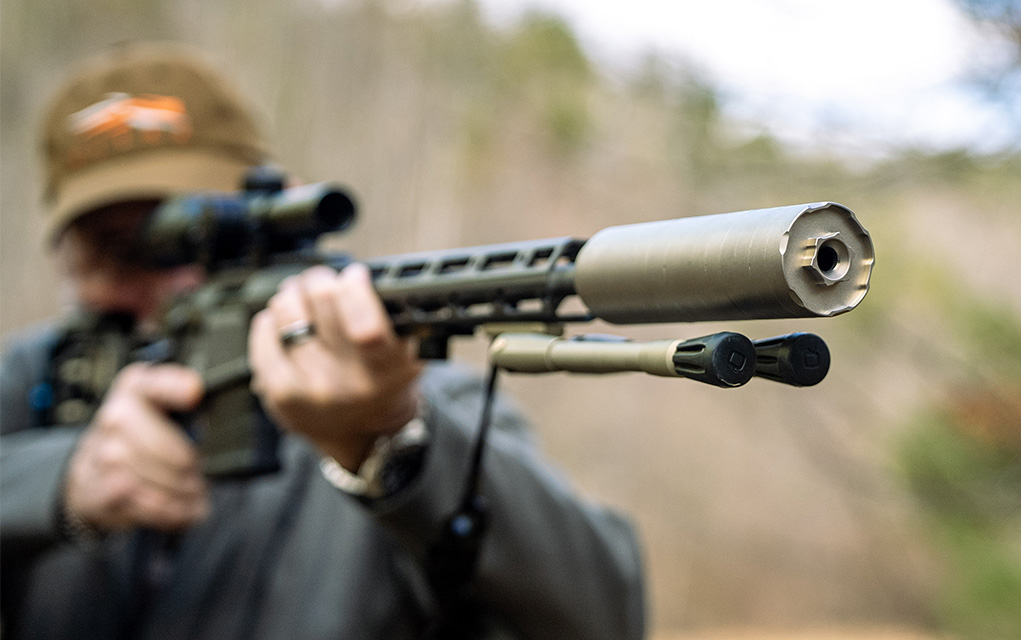Four Ways To Skin A Can

We hit the range with four different rifle suppressors—the MeatEater, Backcountry, Trash Panda and Silent Bandit—to see how they compare.
Throughout time, various trends have left their mark on the history of firearms. While these trends might have various origins, consumers are the driving force. In the 1980s, traditional muzzleloading was popular. In the ’90s, cowboy action shooting was hot. And in the early 2000s, the in-line muzzleloader was all the rage.
About a decade into the new millennium, two things happened to drive current firearm trends. First, Remington and AAC introduced the .300 AAC Blackout cartridge, which jump-started the suppressor craze. And a few years later, the movie American Sniper became the springboard for the current infatuation with long-range shooting. Combined, these two trends make up a large part of the current firearms market.
Suppressor sales are at an all-time high and manufacturers are configuring many new rifles—with shorter barrels and specific cartridges—to better interface with suppressors. Shooters have a decent understanding of rifles and cartridges, but for many, the suppressor is something new.
Here’s a look at four different suppressors that are ideally adapted for pairing with modern centerfire rifles. Together, they offer some insight into construction, serviceability, attachment methods and performance, all of which should help you choose what might be best for you.
Silencer Central Banish Backcountry

Specs
Length: 5.5 inches
Diameter: 1.6 inches
Weight: 7.8 ounces
Caliber: 0.308
Attachment Method: Universal HUB mount
Advertised dB Reduction: 30 dB
dB Test Average (16-inch barreled .308 Win.): 130.15
Price: $1,099
I have more experience with the Banish Backcountry suppressor than any other. I’ve hunted with it a lot—in North America and in Africa—and I’ve used it to evaluate a lot of rifles. It’s one of the lightest and most compact rifle suppressors available. This is an all-titanium can that’s rated to handle 0.308-caliber cartridges up to the .300 Remington Ultra Magnum. It uses the 1.375×24 universal HUB mount, and you order the mount to match the thread pitch on your rifle’s muzzle. A muzzle brake attachment is optional. The main downside to the Banish Backcountry suppressor is that it’s not serviceable—you cannot take it apart and clean it. It’s what’s known as a “sealed” suppressor.


There are some arguments to support both a serviceable and sealed suppressor. Modern high-power rifle cartridges almost exclusively use jacketed bullets, and this prevents lead fouling. Many also burn most of the gunpowder in the barrel. The pressure is also immense—more than 50,000 psi—and as gases exit the barrel, they shake loose and blow out a lot of debris/fouling inside the can. Sealed suppressors can be lighter, there’s no chance you’ll put them together wrong, and they’re generally stronger. They’re very practical for a hunting rifle because you’ll not use them as much—or with lead bullets—like you might with a target or competition rifle.
The beauty of the Banish Backcountry suppressor is its compactness and service-free ruggedness. It’s very practical for hunting rifle applications. However, if you’re looking for a one-suppressor answer for a bunch of different rifles—especially including dirty shooting rimfires and those that will shoot lead bullets—a serviceable suppressor would be a better option.
Silencer Central MeatEater


Specs
Length: 5.85 inches
Diameter: 1.73 inches
Weight: 10.3 ounces
Caliber: 6.5mm or 0.308
Attachment Method: Universal HUB mount
Advertised dB Reduction: 32 dB
dB Test Average (16-inch barreled .308 Win.): 131.7/132.3 dB
Price: $1,299
The more features a can has, the more it will cost, and the MeatEater suppressor is feature heavy. Silencer Central constructs the MeatEater silencer from titanium, and it has an anchor brake. An anchor brake allows you to choose between—more or less—recoil or sound reduction. For example, if you open the brake, it can reduce recoil by as much as 40 percent. If you close the brake, you get less recoil reeducation but more sound suppression.


In my testing, the difference in sound reduction was only between 0.5 and 1.0 decibel (dB). However, the decibel scale is logarithmic as opposed to linear. Linearly, the difference between 131.5 and 132 dB is inconsequential; logarithmically, the difference is more than the numbers suggest.


The MeatEater suppressor is also user-serviceable. By removing the endcap/anchor brake and the HUB mount, you can use a baffle removal tool ($69.99) to take the baffles out of the can and clean them. You can also change the caliber of the hole in the front endcap with a muzzle cap insert, reducing it from 0.308- to 0.264-caliber (6.5mm). If you’re using the MeatEater can on a less than 0.308-caliber rifle, this can help with sound suppression. Also, like the Banish Backcountry, the MeatEater uses the 1.375×24 universal HUB mount.


If you’re looking for a suppressor to use for hunting, but one that you can also use on a variety of other rifles for recreational shooting and maybe even competition, the MeatEater could be a great option.
Q Trash Panda


Specs
Length: 6.91 inches
Diameter: 1.75 inches
Weight: 11.8 ounces
Caliber: 0.308
Attachment Method: Proprietary muzzle device
Advertised dB Reduction: Hearing safe
dB Test Average (16-inch barreled .308 Win.): 132 dB
Price: $1,050
Q is an interesting company, and they’re probably best known for their Honey Badger AR-15-style SBR (short-barreled rifle), and their radical bolt-action rifle called the Fix. But the lineage of Q goes back to the .300 Blackout cartridge developed by Advanced Armament Corporation (AAC). Kevin Brittingham founded AAC, and later, Q. In addition to the Honey Badger and the Fix, like AAC, Q also manufactures suppressors. The Trash Panda suppressor is one of Q’s flagship 0.308-caliber cans.


The Trash Panda is a sealed suppressor rated as hearing safe. It’s made from 100 percent titanium and is a fully laser-welded can without an outer tube. The Trash Panda has a bead-blasted finish and ¾-inch wrench flats on the front and 1-inch wrench flats on the rear, to facilitate easy on and off. It differs from other cans in its attachment method.


The Trash Panda direct threads to Q’s proprietary muzzle device called the Cherry Bomb. The 2-ounce Cherry Bomb has 360-degree porting, which means timing shims are not necessary. It also has an integral ½-inch socket ready nut at the front for installation at 30 to 40 foot-pounds. Cherry Bombs for Q firearms have a taper that precedes the threads, and this taper helps lock the muzzle device in place. (Q offers a specific flat-faced Cherry Bomb for use with non-Q firearms.)


However, the Cherry Bomb itself has an external integral taper forward of the threads for suppressor attachment. This taper helps lock the can in place to prevent it from shooting loose, carbon buildup on the threads and reduces the rotations necessary for suppressor installation.
The Trash Panda makes a great no-worry/never service can for modern high-pressure rifle cartridges shooting jacketed bullets.
Wilson Combat Silent Bandit


Specs
Length: 5.76 inches (5-baffle) ; 6.41 inches (6-baffle)
Diameter: 1.75 inches
Weight: 12.1 (5-baffle) ; 13.3 (6-baffle) ounces
Caliber: 0.233, 0.277, 0.308, 0.358
Attachment Method: Universal HUB mount w/ Quell K-mount compatibility
Advertised dB Reduction: 31 dB
dB Test Average (16-inch barreled .308 Win.): 131.8 dB
Price: $1,119.95 (5-baffle) ; $1,199.95 (6-baffle)
This is a brand-new suppressor released in early 2025. It’s available in either a five- or six-baffle configuration … and in four calibers. Wilson Combat makes the Silent Bandit out of 100 percent Grade 5 titanium, and it has full circumferential welds, a removable HUB mount and front endcap. The can has a black Armor-Tuff finish, and the K-Mount has a black nitride finish.


One thing that sets the Silent Bandit apart is that it’s available in four calibers. You can use all the suppressors here with a smaller diameter cartridge, but using a suppressor that more closely matches the caliber of the cartridge you’re shooting helps maximize noise reduction. The Silent Bandit gives you four options: 0.224-, 0.277-, 0.308- and 0.358-caliber.


For example, if you wanted to suppress 6.5mm or smaller rifle cartridges, you would use the 0.277 Silent Bandit. If you wanted to suppress a .338 Federal or a .350 Legend, you would use the 0.358-caliber version.
The Silent Bandit is compatible with a direct thread, industry standard 1.375 (3/8) x 24 HUB mount, but it comes with Wilson Combat’s Quell K-mount HUB. The Quell K-mount is a flash hider that direct threads and has three benefits. First, it lets you have different K-mounts to match different thread pitches on various rifle muzzles. Second, it reduces the number of revolutions necessary to thread the HUB-equipped suppressor onto the barrel. And finally, with the K-mount attached at between 30 and 50 foot-pounds, it permits you to remove the HUB-mounted suppressor by hand without the K-mount coming off the rifle.


The Silent Bandit comes with a blast chamber/HUB mount spanner wrench and an endcap tool that allows for partial disassembly for cleaning. It makes a great general-purpose suppressor that will work with a broad range of calibers.
The Takeaways
I’ve used all four of these cans on various rifles, and I’d give them all five stars. Granted, their features and ideal applications vary, so a direct comparison is not fair unless you specify the specific reason you want a suppressor.
If I was looking for a dedicated suppressor for a single hunting rifle, of 0.308-caliber or less, I’d go with the Backcountry because of its compactness and lightweight. If I never wanted to worry about my suppressor shooting loose, I’d go with the Trash Panda. The varied caliber options for the Silent Bandit set it apart. And, overall, the MeatEater is the most versatile, but also the most expensive.


As you can see, just as there are various ways to skin a cat, there are multiple ways to make a suppressor. It’s not so much that some ways are better than others, it’s mostly that they are different. You must decide on the differences that best apply to you and your shooting needs.
Editor’s Note: This article originally appeared in the 2025 suppressor special issue of Gun Digest the Magazine.
More On Suppressors:
Read the full article here









